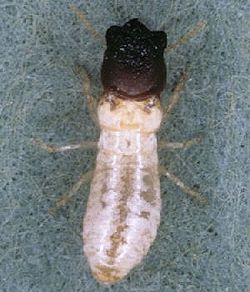Cryptotermes
| Den här artikeln har skapats av Lsjbot, ett program (en robot) för automatisk redigering. (2013-06) Artikeln kan innehålla fakta- eller språkfel, eller ett märkligt urval av fakta, källor eller bilder. Mallen kan avlägsnas efter en kontroll av innehållet (vidare information) |
| Cryptotermes | |
 | |
| Systematik | |
|---|---|
| Domän | Eukaryoter Eukaryota |
| Rike | Djur Animalia |
| Stam | Leddjur Arthropoda |
| Understam | Sexfotingar Hexapoda |
| Klass | Egentliga insekter Insecta |
| Ordning | Isoptera |
| Familj | Kalotermitidae |
| Släkte | Cryptotermes |
| Vetenskapligt namn | |
| § Cryptotermes | |
| Hitta fler artiklar om djur med | |
Cryptotermes[1] är ett släkte av termiter. Cryptotermes ingår i familjen Kalotermitidae.[1]
Kladogram enligt Catalogue of Life[1]:
| Kalotermitidae |
| |||||||||||||||||||||||||||||||||||||||||||||||||||
Bildgalleri
- (c) CSIRO, CC BY 3.0
- (c) CSIRO, CC BY 3.0
- (c) CSIRO, CC BY 3.0
- (c) CSIRO, CC BY 3.0
- (c) CSIRO, CC BY 3.0
- (c) CSIRO, CC BY 3.0
Källor
- ^ [a b c] Bisby F.A., Roskov Y.R., Orrell T.M., Nicolson D., Paglinawan L.E., Bailly N., Kirk P.M., Bourgoin T., Baillargeon G., Ouvrard D. (red.) (22 september 2011). ”Species 2000 & ITIS Catalogue of Life: 2011 Annual Checklist.”. Species 2000: Reading, UK. http://www.catalogueoflife.org/annual-checklist/2011/search/all/key/cryptotermes/match/1. Läst 24 september 2012.
Externa länkar
 Wikimedia Commons har media som rör Cryptotermes.
Wikimedia Commons har media som rör Cryptotermes. Wikispecies har information om Cryptotermes.
Wikispecies har information om Cryptotermes.
Media som används på denna webbplats
Robot icon
(c) CSIRO, CC BY 3.0
Workers of the drywood termite Cryptotermes domesticus (Isoptera: Kalotermitidae) sitting on softwood from Monterey pine Pinus radiata (Coniferales: Pinaceae) . Termite workers generate vibrations when biting their wood food. The dominant resonant frequency of these vibrations is related to the size of the wood. The termites can perceive these vibration signals and use them to assess the size of the wood. Termites also appear to be able to determine the source of the vibration signals, and use them to make foraging decisions and development and reproduction decisions based on this information.
(c) CSIRO, CC BY 3.0
Researchers from CSIRO and UNSW@ADFA have shown that termites can tell what sort of material their food is made of, without having to actually touch it. The findings may lead to improvements in the control of feeding termites. By offering them a choice between normal wooden blocks and specially designed blocks made of wood and other materials, the researchers found that the termites always preferred the blocks containing the most wood – even though they could not touch or see the other materials. Dr Ra Inta, from UNSW@ADFA and CSIRO Entomology, says the ability to differentiate between food sources is based on the vibrations of the food that the termites are eating, although the exact mechanism for this ability is yet to be explored.
(c) CSIRO, CC BY 3.0
Workers of the drywood termite Cryptotermes domesticus (Isoptera: Kalotermitidae) sitting on softwood from Monterey pine Pinus radiata (Coniferales: Pinaceae) . Termite workers generate vibrations when biting their wood food. The dominant resonant frequency of these vibrations is related to the size of the wood. The termites can perceive these vibration signals and use them to assess the size of the wood. Termites also appear to be able to determine the source of the vibration signals, and use them to make foraging decisions and development and reproduction decisions based on this information.
(c) CSIRO, CC BY 3.0
The drywood termites Cryptotermes secundus form small colonies and have few workers. They can 'eavesdrop' on their more aggressive relatives Coptotermes acinaciformis. Both species eat sound dry wood and can co-exist in the same tree but, while drywood termite colonies contain only about 200 individuals and are confined to one tree, colonies of Coptotermes – Australia's dominant wood-eating termite – contain around a million individuals, including thousands of aggressive soldiers, and can forage on up to 20 trees simultaneously. According to CSIRO Entomology's Dr Theo Evans "we already knew that chewing termites generate vibrations which they use to determine wood size and quality, so it seemed possible that one species could detect another using these vibrations.” His research team found that Cryptotermes could use vibration signals to distinguish between their own and Coptotermes individuals. They would even respond to recorded
(c) CSIRO, CC BY 3.0
Researchers from CSIRO and UNSW@ADFA have shown that termites can tell what sort of material their food is made of, without having to actually touch it. The findings may lead to improvements in the control of feeding termites. By offering them a choice between normal wooden blocks and specially designed blocks made of wood and other materials, the researchers found that the termites always preferred the blocks containing the most wood – even though they could not touch or see the other materials. Dr Ra Inta, from UNSW@ADFA and CSIRO Entomology, says the ability to differentiate between food sources is based on the vibrations of the food that the termites are eating, although the exact mechanism for this ability is yet to be explored.
(c) CSIRO, CC BY 3.0
Workers of the drywood termite Cryptotermes domesticus (Isoptera: Kalotermitidae) sitting on softwood from Monterey pine Pinus radiata (Coniferales: Pinaceae) . Termite workers generate vibrations when biting their wood food. The dominant resonant frequency of these vibrations is related to the size of the wood. The termites can perceive these vibration signals and use them to assess the size of the wood. Termites also appear to be able to determine the source of the vibration signals, and use them to make foraging decisions and development and reproduction decisions based on this information.












